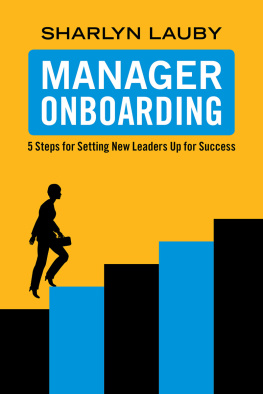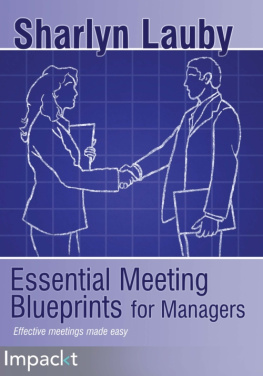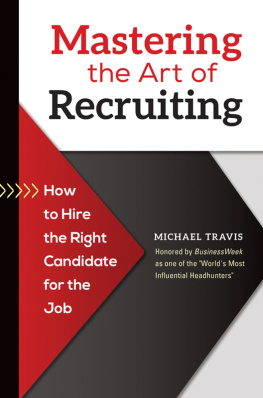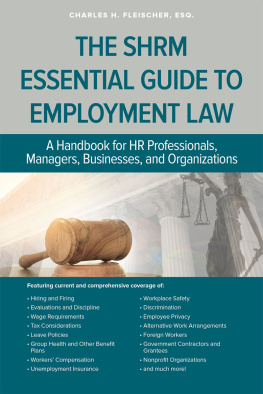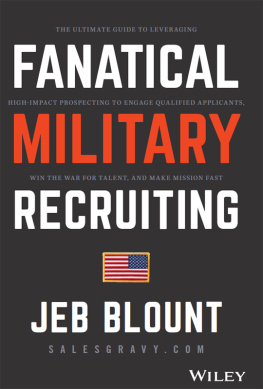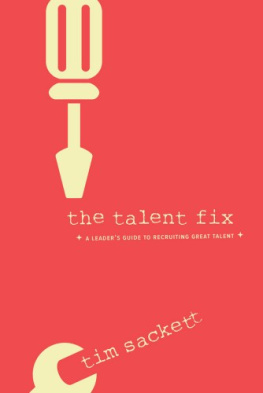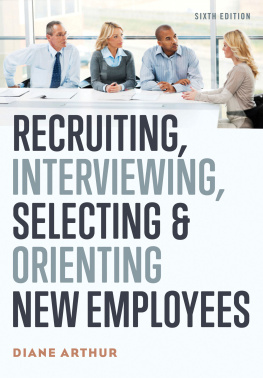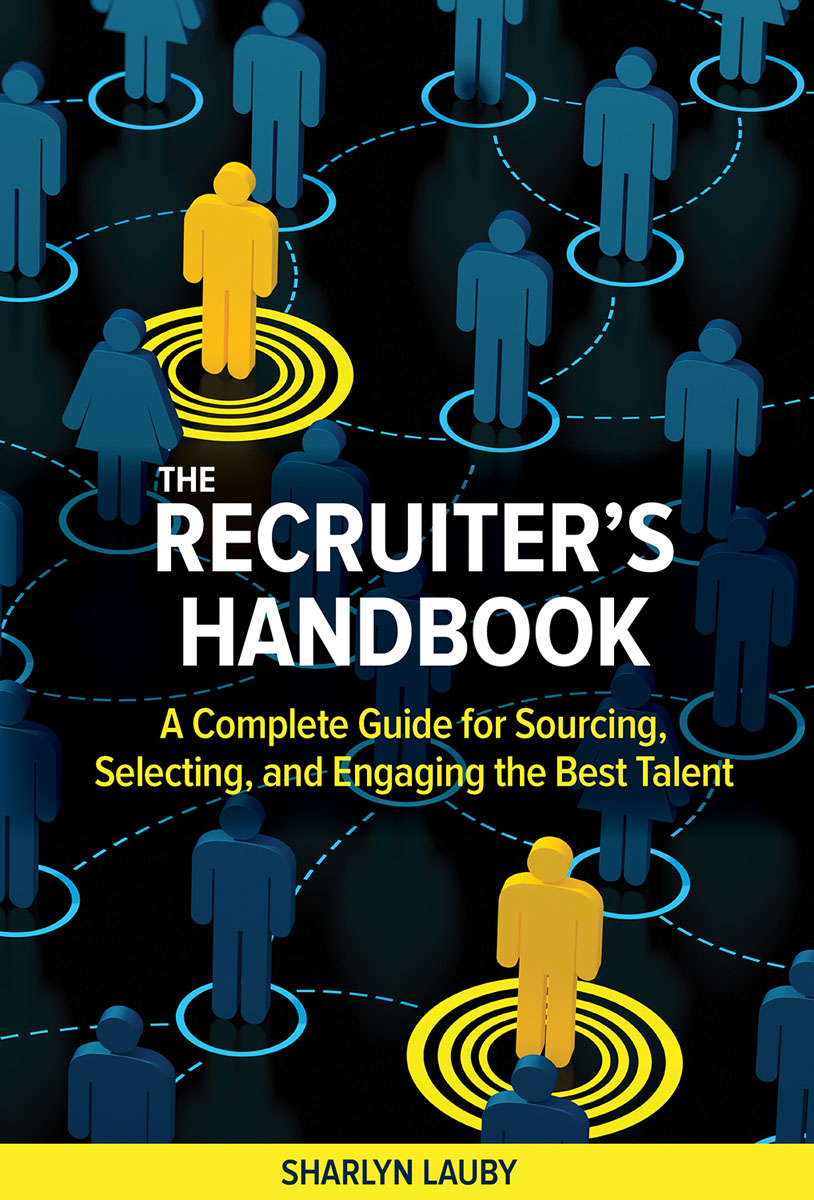

Copyright 2018 Sharlyn Lauby. All rights reserved.
This publication is designed to provide accurate and authoritative information regarding the subject matter covered. It is sold with the understanding that neither the publisher nor the author is engaged in rendering legal or other professional service. If legal advice or other expert assistance is required, the services of a competent, licensed professional should be sought. The federal and state laws discussed in this book are subject to frequent revision and interpretation by amendments or judicial revisions that may significantly affect employer or employee rights and obligations. Readers are encouraged to seek legal counsel regarding specific policies and practices in their organizations.
This book is published by the Society for Human Resource Management (SHRM). The interpretations, conclusions, and recommendations in this book are those of the author and do not necessarily represent those of the publisher.
This publication may not be reproduced, stored in a retrieval system, or transmitted in whole or in part, in any form or by any means, electronic, mechanical, photocopying, recording, or otherwise, without the prior written permission of the publisher, or authorization through payment of the appropriate per-copy fee to the Copyright Clearance Center, Inc., 222 Rosewood Drive, Danvers, MA 01923, 978-750-8600, fax 978-646-8600, or on the Web at ww.copyright.com. Requests to the publisher for permission should be addressed to SHRM Book Permissions, 1800 Duke Street, Alexandria, VA 22314, or online at www.shrm.org/about-shrm/pages/copyright--permissions.aspx.
SHRM books and products are available on most online bookstores and through the SHRMStore at www.shrmstore.org.
The Society for Human Resource Management is the worlds largest HR professional society, representing 285,000 members in more than 165 countries. For nearly seven decades, the Society has been the leading provider of resources serving the needs of HR professionals and advancing the practice of human resource management. SHRM has more than 575 affiliated chapter within the United States and subsidiary offices in China, India, and United Arab Emirates. Please visit us at www.shrm.org.
Library of Congress Cataloging-in-Publication Data
Names: Lauby, Sharlyn, author.
Title: The recruiters handbook : a complete guide for sourcing, selecting, and engaging the best talent / Sharlyn Lauby.
Description: Alexandria, Virginia : Society for Human Resource Management, [2018] | Includes bibliographical references and index.
Identifiers: LCCN 2017053969| ISBN 9781586444655 (pbk.) | ISBN 9781586444679 (epub) | ISBN 9781586444686 (mobi)
Subjects: LCSH: Employees--Recruiting. | Employee selection. | Personnel management.
Classification: LCC HF5549.5.R44 L377 2018 | DDC 658.3/11--dc23
Printed in the United States of America
FIRST EDITION
PB Printing 10 9 8 7 6 5 4 3 2 1
61.14516 | 17-0958
Table of Contents
Acknowledgments
Ive always said that a book never happens alone.
I want to thank the wonderful people who helped me make this book happen. First, a huge thanks to Tony Lee, Matthew Davis, and the team at SHRM for giving me this opportunity. I also want to thank Shirley Raybuck for her design expertise, Holly Alexander for being a fantastic editor, and Kate Mertes for indexing all of the content.
Its been wonderful working with everyone. I learn something new with every book, and this one is no exception.
A huge thanks to my clients and colleagues who contributed their expertise. You didnt have to answer my request, but Im sure glad you did. Im very fortunate to have such giving professionals in my network. And I know readers will find your insights valuable.
Last but certainly not least, all my love and admiration to my husband, Keith. Writing a book becomes a family activity in the Lauby household, and hes a great sport about it. I owe him one very long vacation.
Thank you all and enjoy the read. Cheers!
Sharlyn Lauby
Foreword
Finding, interviewing and hiring employees have always been a challenge and priority for any size company, in any industry and in every country. Whats different today is that we have an ever-growing skills gap, a more fluid job market, and emerging generations that have a different set of expectations.
After the 2008 U.S. recession, companies are hiring slower and the amount of jobs available in the economy has been steadily increasing, while employee retention has been declining at a similar pace. Almost two-thirds of companies are unable to find skilled candidates and almost one-fourth of employees are planning to change jobs. To add to the complexity, companies have to account for four generations of employees, who have different needs and are divided by trends in culture and technology. Millennials and Generation Z account for about half of the workforce, yet at the same time the proportion of Baby Boomers is growing and aging past retirement. Catering to these generations will become increasingly complex and stressful for recruiters and HR leaders. These four trends are all interrelated and have created a global war for talent that has companies altering their employer value proposition, prioritizing employer branding and redesigning their offices and benefits to appeal to all types of candidates.
Compensation matters. The one thing that has remained constant in my over ten years of workplace research is compensation. Regardless of your age, gender or ethnic background, cash has been king. The one subtle difference today compared to years past is that the conversation has moved from trying to make as much money as possible to fair pay. With access to salary data from PayScale.com, and the no longer taboo conversations about pay between workers, companies need to focus first and fair pay before even thinking about benefits.
Flexible workplaces attract candidates and keep employees. One of the most profound changes Ive witnessed since 2014 is the prioritization of work flexibility over health-care coverage, following two global millennial studies I worked on with Randstad. After fair pay, all of my peers want a more flexible work environment, which includes a modern office design, to the ability to telecommute, casual dress, job sharing, additional maternal and paternal leave, and flexible hours. Gallup reports that the average workweek has expanded to 47 hours and with smartphones, we are working outside of office hours, resulting in a desire to have more freedom and flexibility. As further evidence, about a third of our economy is gig workers, and through several studies we found that the top reason they choose to freelance is for flexibility. Its a clear sign that companies need to create flexibility programs and then market them in their recruiting initiatives.
Technology isnt a substitute for good managers. Professionals today want to work at organizations with well-developed cultures, pay and benefits, and empathetic leaders. Dont think for a second that all the hype around new technology developments, including chatbots and artificial intelligence, will solve all of your recruiting problems. The most effective tool for recruiting and retaining talent is human interactions, having managers that support internal career development and learning initiatives and a culture where employees feel safe to share new ideas. While a machine might help remove unconscious bias in the recruiting process, dont ever hire anyone without first meeting them! A bad hire can cost you money, time and productivity, that you cant afford to lose when growing your business.
Next page

